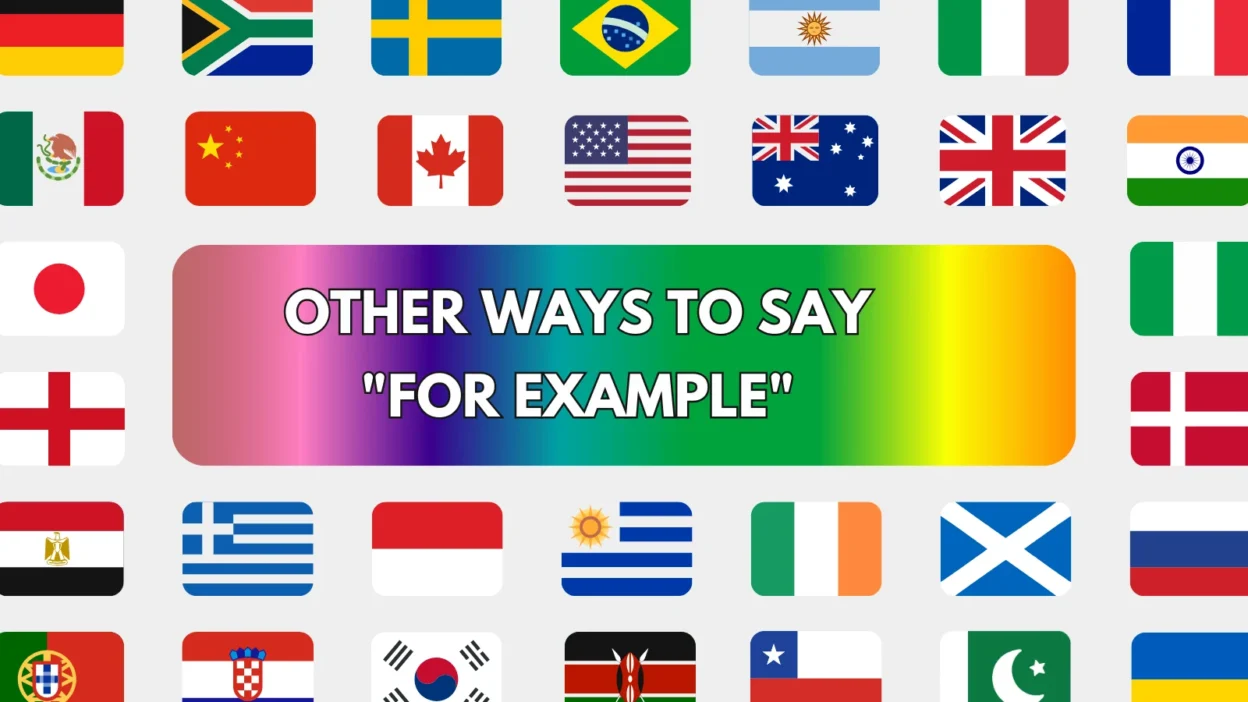The phrase “for example” is used constantly in writing, teaching, and conversation to clarify a statement or support a point with specific cases. While effective, relying on it too often can make your language feel repetitive or overly simplistic. That’s where variety comes in. Using different alternatives lets you match the tone, structure, and style of your message—making your communication more precise and engaging.
In this article, you’ll discover 25 smart, useful alternatives to “for example,” each with a clear meaning, a detailed explanation, real-world usage, best context, and tone description. Whether you’re working on a presentation, email, paper, or speech, this guide will help you say more—more clearly, more professionally, and more interestingly.
1. Such As
Meaning: This phrase is used to introduce examples that belong to a general category. It gives specific illustrations without needing to start a new sentence.
Detailed Explanation: “Such as” is a polished and widely used alternative to “for example.” It usually appears in the middle of a sentence and allows you to provide one or more examples smoothly. It’s not as strong in tone as “for example,” which often draws more attention. Instead, “such as” feels integrated and subtle.
Scenario Example: The school offers many extracurriculars, such as drama club, robotics, and debate team.
Best Use: Formal or semi-formal writing, academic work, business reports.
Tone: Polished, neutral, professional.
2. For Instance
Meaning: This phrase introduces a specific case that illustrates a broader idea or category.
Detailed Explanation: “For instance” works almost exactly like “for example” but can sound slightly more conversational depending on the setting. It’s flexible and effective across both written and spoken formats. Its placement usually starts a new clause or sentence, drawing attention to the supporting example.
Scenario Example: Some countries have strict recycling laws. For instance, Germany requires citizens to separate waste into six categories.
Best Use: General writing, presentations, formal and informal explanations.
Tone: Neutral, accessible, slightly conversational.
3. Namely
Meaning: This term is used to identify or clarify something with exact specificity.
Detailed Explanation: “Namely” is more formal and direct than “for example.” It doesn’t just offer any example—it precisely names the thing being discussed. It works well when you want to restate or define something narrowly, usually after a generalization.
Scenario Example: Only one employee met all the project deadlines—namely, Sarah.
Best Use: Academic writing, formal reports, official statements.
Tone: Precise, formal, confident.
4. In Particular
Meaning: This phrase draws attention to one or more specific items from a broader group.
Detailed Explanation: Unlike “for example,” which introduces a range of cases, “in particular” highlights a standout or especially relevant case. It signals focus rather than variety. It’s best used when you want to emphasize something of special importance.
Scenario Example: He loves many genres of music, in particular, jazz and classical.
Best Use: Analytical writing, opinions, emphasis in speeches.
Tone: Emphatic, reflective, moderately formal.
5. To Illustrate
Meaning: This phrase introduces an example used to clarify a concept or idea.
Detailed Explanation: “To illustrate” is slightly more formal than “for example” and is great when you’re trying to explain or teach something. It suggests that the example is being used to shed light on a more complex point.
Scenario Example: To illustrate, consider how bees communicate using a waggle dance.
Best Use: Teaching, writing explanations, presentations.
Tone: Educational, explanatory, clear.
6. Like
Meaning: A casual word used to list examples that belong to a certain group or idea.
Detailed Explanation: “Like” is an informal alternative to “for example” and is often used in speech or relaxed writing. It’s short, natural, and works well in everyday conversation—but it’s not ideal for academic or professional documents.
Scenario Example: I enjoy outdoor activities like hiking, biking, and kayaking.
Best Use: Informal conversation, social media, friendly writing.
Tone: Casual, conversational, relaxed.
7. Say
Meaning: Used informally to introduce a hypothetical example or instance.
Detailed Explanation: “Say” is not a direct synonym for “for example” but can act like one in spoken English. It implies a spontaneous example, often imagined for illustrative purposes. It works best when paired with a scenario or idea that isn’t literal but helps make a point.
Scenario Example: Say you forget your keys at home—how would you get back in?
Best Use: Informal conversation, explanations, storytelling.
Tone: Casual, imaginative, informal.
8. To Give You an Example
Meaning: A phrase used to explicitly introduce a specific case or example for clarity.
Detailed Explanation: This is a longer and more emphatic way to say “for example.” It signals that you’re making your point clearer with a supporting illustration. It works well in teaching, explanations, or storytelling where engagement and clarity are important.
Scenario Example: To give you an example, our costs dropped by 15% after automating the system.
Best Use: Presentations, lectures, emails with context.
Tone: Explanatory, polite, informative.
9. Specifically
Meaning: Used to narrow down from a general point to a precise detail.
Detailed Explanation: “Specifically” can serve the same function as “for example,” but it emphasizes precision. It works best when you want to avoid vagueness or generalities and get straight to a concrete point.
Scenario Example: We need to improve customer response times—specifically, in the tech support department.
Best Use: Business writing, proposals, analysis.
Tone: Precise, sharp, formal.
10. Consider
Meaning: A directive to think about a specific situation or case that illustrates a point.
Detailed Explanation: “Consider” introduces an example in a reflective way. It suggests the example is part of a thought exercise or mental illustration, making it ideal for persuasive or thoughtful writing.
Scenario Example: Consider a freelancer who works without contracts—this often leads to payment disputes.
Best Use: Persuasive writing, articles, essays.
Tone: Thoughtful, academic, persuasive.
11. Let’s Say
Meaning: A phrase used to introduce a hypothetical example.
Detailed Explanation: “Let’s say” is especially effective in conversational or instructional scenarios where you want to simplify a concept. It’s like inviting the listener into a shared mental exercise.
Scenario Example: Let’s say you earn $1,000 a week. Saving just 10% can really add up.
Best Use: Presentations, coaching, teaching moments.
Tone: Conversational, engaging, informal.
12. Among Others
Meaning: Used to indicate that there are additional examples beyond the ones listed.
Detailed Explanation: “Among others” doesn’t introduce the first example but follows it, suggesting the list is not complete. It avoids being too exhaustive and keeps things open-ended.
Scenario Example: She’s fluent in French, Spanish, and German, among others.
Best Use: Academic writing, resumes, summaries.
Tone: Formal, flexible, reserved.
13. Including
Meaning: Adds one or more examples to a general statement.
Detailed Explanation: “Including” suggests the examples mentioned are part of a bigger group. It’s usually embedded within a sentence and is very efficient, although not as attention-grabbing as “for example.”
Scenario Example: We offer several free services, including consultation and support.
Best Use: Marketing, business copy, technical writing.
Tone: Efficient, neutral, professional.
14. As an Example
Meaning: Provides a specific case to illustrate a statement.
Detailed Explanation: This phrase is very close in use to “for example,” but sounds slightly more structured and is more common in formal writing. It adds clarity and rhythm to your sentence.
Scenario Example: As an example, let’s look at how Tesla disrupted the car market.
Best Use: Reports, instruction manuals, essays.
Tone: Formal, informative, neutral.
15. Case in Point
Meaning: Introduces an example that strongly supports the previous argument.
Detailed Explanation: “Case in point” is typically used after a point has been made to provide clear evidence or illustration. It adds impact and is common in persuasive writing or speech.
Scenario Example: Remote work improves productivity. Case in point: our sales team exceeded their targets last quarter.
Best Use: Persuasive writing, debates, arguments.
Tone: Assertive, confident, formal.
16. One Example Is
Meaning: Highlights a single instance that supports your claim.
Detailed Explanation: This phrase puts emphasis on one specific case rather than offering a range. It’s a great way to slow down your argument and give it weight.
Scenario Example: One example is Amazon’s use of AI to predict customer behavior.
Best Use: Explanatory content, business writing, instruction.
Tone: Clear, structured, moderately formal.
17. Imagine
Meaning: Asks the audience to picture a specific case, usually hypothetical.
Detailed Explanation: “Imagine” is an attention-grabber that introduces a scenario rather than a traditional example. It’s best for speeches, marketing, and persuasive language.
Scenario Example: Imagine you’re launching a product with zero budget. How would you market it?
Best Use: Public speaking, storytelling, content creation.
Tone: Engaging, creative, informal.
18. Suppose
Meaning: Offers a hypothetical case to help make a point clearer.
Detailed Explanation: “Suppose” is similar to “say” or “imagine,” and works well for building thought experiments. It’s often used in tutorials, discussions, or articles with complex topics.
Scenario Example: Suppose you double your savings rate—how long until you retire early?
Best Use: Lessons, coaching, reflective writing.
Tone: Analytical, curious, thought-provoking.
19. Exhibit A
Meaning: Introduces a leading or primary example, often humorously or dramatically.
Detailed Explanation: This phrase borrows from courtroom language and can be used playfully or to emphasize a particularly compelling example.
Scenario Example: He always says he eats healthy. Exhibit A: a drawer full of candy bars.
Best Use: Casual writing, blogs, humor, commentary.
Tone: Humorous, dramatic, informal.
20. A Good Example Is
Meaning: Highlights a well-suited or typical case that supports your point.
Detailed Explanation: This version is friendly and more descriptive than “for example.” It suggests you’re offering an ideal representation of the idea in question.
Scenario Example: A good example is Canva, which simplified graphic design for non-designers.
Best Use: Teaching, writing guides, case studies.
Tone: Warm, clear, instructional.
21. As Seen In
Meaning: Introduces evidence or support from a previously known source or case.
Detailed Explanation: “As seen in” is often used in formal or marketing contexts to point to a real-life validation or proven example.
Scenario Example: As seen in Apple’s product launches, minimalism boosts emotional appeal.
Best Use: Business writing, case studies, articles.
Tone: Confident, factual, authoritative.
22. Including But Not Limited To
Meaning: Clarifies that the examples provided are part of a larger group.
Detailed Explanation: This phrase is more legal or technical in nature. It shows you are listing items, but not restricting the list only to those items.
Scenario Example: The plan covers expenses including but not limited to travel, lodging, and meals.
Best Use: Contracts, formal writing, terms & conditions.
Tone: Technical, formal, precise.
23. That Is
Meaning: Offers clarification or further detail about what has just been said.
Detailed Explanation: While not strictly a synonym, “that is” often introduces a clarifying example or a narrower restatement of the general idea.
Scenario Example: We need to address external risks—that is, supplier delays and shipping errors.
Best Use: Explanatory writing, analysis, documentation.
Tone: Analytical, formal, clear.
24. Consider the Case Of
Meaning: Introduces a real or hypothetical case as a teaching tool.
Detailed Explanation: This phrase makes your example sound like a case study or formal illustration, which adds weight and credibility.
Scenario Example: Consider the case of Netflix, which went from DVD rentals to streaming dominance.
Best Use: Academic writing, case studies, presentations.
Tone: Serious, structured, formal.
25. Take X as an Example
Meaning: Suggests looking at a specific person, item, or idea to understand a point.
Detailed Explanation: This format personalizes the example. It’s flexible and conversational, while still guiding the reader to reflect or analyze.
Scenario Example: Take Uber as an example of how technology disrupted a traditional industry.
Best Use: Business examples, opinion pieces, lectures.
Tone: Conversational, illustrative, direct.
Conclusion
While “for example” is a solid and widely accepted phrase, it can become stale or repetitive when overused. With these 25 alternatives in your toolkit, you can tailor your message to suit your tone, purpose, and audience.
Whether you want to sound formal, casual, persuasive, or educational. Try incorporating different expressions based on your situation, and you’ll instantly make your communication more dynamic, nuanced, and professional.




